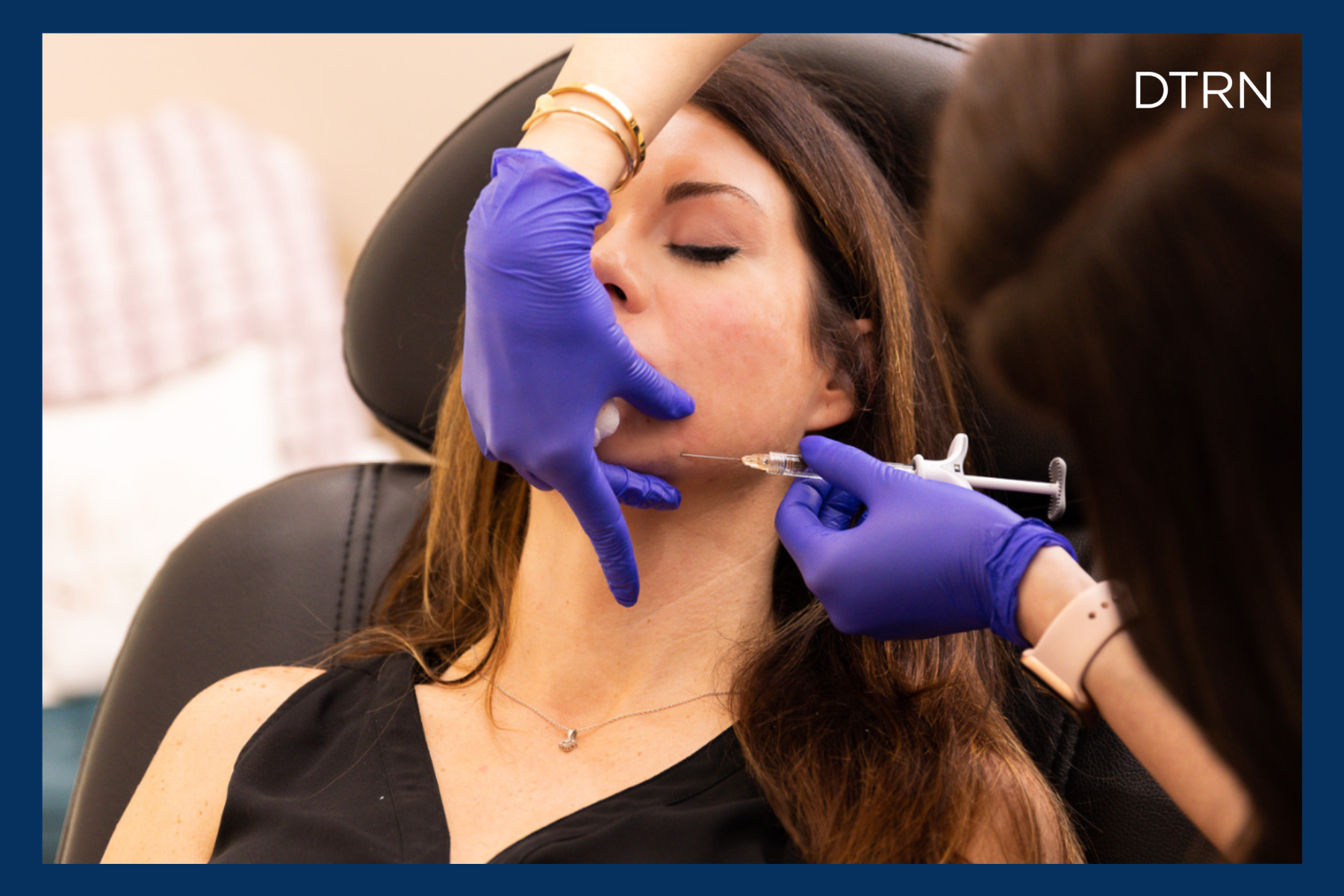What Happens When Fillers Wear Off?

If you’re considering a dermal filler treatment, you might be wondering about what happens when fillers wear off. In this post, we answer that question and many more.
Dermal fillers have become one of the most popular minimally invasive cosmetic treatments in recent years, coming in only second behind neuromodulator treatments, like Botox injections. Per the American Society of Plastic Surgeons, more than 3.4 million soft dermal tissue treatments were done in 2020. In 2021, the dermal filler market was estimated to be around USD 5.05 billion, with an estimated increase to USD 8.79 billion by 2029.
These stats suggest that the dermal filler market isn’t going anywhere, and more and more people will either return for a filler treatment or schedule for their first filler treatment, with no signs of stopping. If you’re new to the market or considering your first dermal filler treatment, you likely have several questions, with one important one being “What happens when fillers wear off?”
To answer this question and more, we turned to Houston-based Registered Nurse, Allergan Trainer, and Injector Nicole Sarmiento. She specializes in cosmetic treatments, including Botox and dermal fillers.
What are dermal fillers, and how do they work?
First, let’s discuss what dermal fillers are and how they work.
Dermal fillers are a family of safe injectable hyaluronic acid fillers and offer a non-surgical solution for the signs of aging skin, as well as for the correction of facial contours. Dermal fillers are injected into the skin, and with many types of fillers, you see immediate results. Some fillers don’t provide immediate results, but instead add volume over time after being injected into the skin.
Are dermal fillers safe?
Facial dermal fillers have an excellent safety record and are a great alternative to surgery. They plump the skin and provide a refreshed, youthful, and rested appearance. The temporary nature of Juvederm and other dermal fillers offers clients an opportunity to “try them out” and see the beautiful possibilities of minimizing the signs of aging.
What are the different types of dermal fillers?
“There are many different types of fillers,” shares Sarmiento, “Some are made from material like polymethylmethacrylate, poly-l-lactic acid, calcium hydroxylapatite, collagen, or autologous fat injections. The most common and popular type of filler is HA, or hyaluronic acid filler, like Juvederm.”
Some filler lines, like Restylane and Juvederm, have several filler types within the same family with different efficacies and treatment areas of focus. Restylane, for example, includes:
- Restylane-L
- Silk
- Lyft
- Defyne
- Refyne
The Juvederm family of fillers includes:
- Ultra
- Ultra Plus
- Volbella
- Voluma
- Vollure
- Volux
For the purposes of this blog, we primarily focus on HA fillers.
What is hyaluronic acid (HA)?
As Sarmiento mentioned, HA fillers are the most popular dermal fillers on the market. Of the 3.4 million soft dermal filler treatments mentioned in the opening above, 2.6 million were HA fillers.
So, what exactly is HA or hyaluronic acid?
Hyaluronic acid is one of the body’s natural moisturizers and fills in the spaces between our skin cells. It is a naturally occurring carbohydrate that is responsible for the plumb, rested look of youthful skin. Hyaluronic acid in our skin decreases as we age, particularly after 40, and HA fillers for the face are a viable option to restore the look of youth and volume for the skin.
What are dermal fillers used to treat?
Dermal fillers help address and resolve a number of concerns. Fillers plump up the chosen areas and help restore a youthful look to aging skin, as well as add symmetry and enhance beauty to the facial features. Thin lips can be made more luscious with lip injections. Asymmetrical facial contours can be corrected. Juvederm, in particular, is a great option to fill in facial folds and soften the appearance of wrinkles. Additional treatment options include, but are not limited to:
- Augmenting the cheeks and cheekbone contours
- Plumping or correcting thin lips
- Restoring youthful, more supple contours of the face
- Correcting moderate to severe wrinkles of the face
- Filling in acne scars to reduce their appearance
- Augmenting and contouring the chin
- Contouring the jawline
Sarmiento shares that facial balancing is very important to her as an injector. “Facial balancing is important because it helps to restore lost volume to the face and improve facial proportions. My two favorite fillers for balancing the upper and lower face are Juvederm Voluma and Juvederm Volux. I use Voluma to help contour and fill the cheeks, and I use Volux to contour/define the jawline and chin.”
How long do dermal fillers last?
The length of time that dermal fillers will give you the enhanced look and solutions you desire varies from individual to individual based on how much is used, individual body chemistry, where the filler is injected, and the type of filler used. However, the typical dermal filler will last from 6 to 24 months. For example, if we look at the Juvederm line of fillers:
- Juvederm Ultra lasts for up to 12 months and is used to add volume to the lips and treat moderate to severe facial wrinkles and folds.
- Ultra Plus tends to last beyond 12 months and helps to fill moderate to severe facial wrinkles and folds.
- Voluma lasts for up to 24 months and is the first FDA-approved filler for chin augmentation. It’s also used to correct age-related volume loss.
- Vollure lasts for up to 18 months and is used to add subtle volume to smooth moderate to severe facial folds and wrinkles.
- Volbella lasts for up to 12 months, helps to soften the look of perioral lines around the mouth, and adds subtle volume to the lips.
- Velux lasts for up to a whopping 24 months and is the first FDA-approved filler to smooth and contour the jawline. It is also used to augment and contour the chin.
What happens when fillers wear off?
Now, let’s move on to one of the most pressing questions: What happens when fillers wear off?
As dermal fillers wear off, the body absorbs the filler.
“As non-permanent filler, such as Juvederm, starts to break down, the body naturally absorbs it,” states Sarmineto, “The skin rebounds and resumes the form prior to undergoing treatment.”
If you’d like to maintain results, additional treatments are necessary.
Does a person’s skin look older when someone stops getting dermal fillers?
It’s also common to wonder what would happen to your skin if you chose to stop getting dermal filler treatments in the future. Nicole helps to ease your mind if you were concerned you might look older. In fact, you might even look better than your pre-filler treatment days.
“The skin will not look older,” Sarmiento points out, “Long after the filler’s effects have worn off, patients even find that their skin continues to look better than it did originally.”
How much does a dermal filler treatment cost?
Dermal filler treatment costs can vary greatly depending on your location, the practitioner, the treatment area, the amount of filler used, and the type of filler used. A Juvederm filler treatment, for example, can range from $400 to $3000 and upwards.
Sarmiento also points out that, in terms of expense, it’s important to budget for the cost of maintaining treatments. Since dermal filler dissolves over time, you’ll want to keep up with your dermal filler treatments to maintain the results you love.
How much filler will I need?
The amount of dermal filler used depends on the individual, the results desired, and the area of the face being filled. The type of dermal filler product is also a factor in determining the amount of filler required for desired results.
At DermaTouch RN, your dermal filler specialist will access your individual needs and talk with you about your desired results. Your highly trained specialist will design a plan to suit your personal goals. Each individual treatment plan varies based on the unique circumstances for each person being treated.
How long before any swelling goes down after treatment?
Once you’ve had your dermal filler treatment, you’ll be pleased to know that most clients can resume their regular daily routine right away. In some cases, you might need a little extra time, but it’s unlikely to be more than a day.
It takes about two weeks for the filler to fully settle for your “final” result.
For tips on how to not be disappointed with your dermal filler treatment, consider reading “How to Not Be Disappointed With Your Juvederm Filler Treatment”
Consider a dermal filler consultation
Suppose you’re still unsure whether a dermal filler treatment is right for you or have specific questions. In that case, we encourage you to schedule a dermal filler consultation at your local MedSpa. This is a great opportunity to get personalized advice and make an informed decision.
The team at DermaTouch RN has been going strong for more than 15 years! You can book online 24/7 or give us a call at our Houston or San Antonio locations to schedule your dermal filler consultation or appointment!
Nicole Sarmiento, BSN, RN

NURSE INJECTOR
Nicole became a Registered Nurse in 2011 after obtaining a Bachelor of Science in Nursing. Since 2013, her focus has been in Medical Aesthetics. Her background includes Botox, Dysport, Fillers, CoolSculpting ELITE, Ultherapy, BBL and Laser Hair Reduction. Nicole enjoys teaching and educating her clients. She has a strong passion for the aesthetic industry, and most importantly, helping others feel and look their absolute best.
In 2022, Nicole became a Trainer for The Allergan Medical Institute® and currently provides training on Botox, Juvederm and Kybella to new and existing practices in South Texas. She enjoys sharing her experiences on how to achieve great client outcomes with injectables.
DermaTouch RN offers minimally invasive and non-invasive treatments for men and women in Houston, San Antonio, Spring and Cypress, as well as the surrounding areas of Texas. We are the largest aesthetic practice in the Houston area, and all of our medical spa treatments are performed by a team of nurse practitioners, registered nurses, and aestheticians who receive continuing education to remain abreast of emerging treatments that benefit our patients. We invite you to learn more about our office before your consultation.




